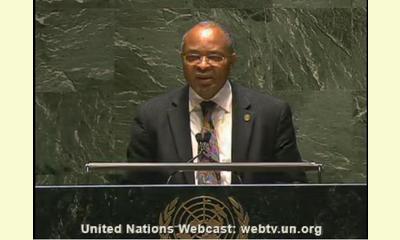|
|
Member States Support Culture of Peace at the UN
un articulo por David Adams, CPNN Coordinator
Video: UN Forum on Culture of
Peace
As mentioned in last
month's CPNN bulletin, there were high-level
meetings on the culture of peace at United Nations
Headquarters in New York on September 14 and 21.
Secretary-General Ban Ki-Moon spoke at both
meetings (see CPNN articles on September 16 and September 22 ). Many member
states attended the meetings, some of them taking
the floor to speak. Here are some of their
remarks, details of which may be found in the
video listed above.

The representative of Benin speaking on the culture of peace (from UN video)
click on photo to enlarge
The representative from Bangladesh recalled the
adoption of the Declaration and Programme of
Action on a Culture of Peace in 1999, and the
annual UN resolutions for a culture of peace each
year since then, for which his country has taken
the leadership role. He called for a global
transition from a mindset of culture of war to a
mindset of culture of peace with the participation
of all sectors, governments, international
organizations, civil society, NGOs, young people,
private sector, community leaders, religious
leaders, teachers, artists, journalists,
humanitarian workers and more importantly media .
The representative of Benin put his emphasis on
education for values and the common good for all
humanity. He recalled that Benin went through a
political crisis at the beginning of the 90s which
was resolved through dialogue and the
establishment of democracy based on justice and
human rights.
The representative from Costa Rica deplored the
continued growth in weapons expenditures and the
failure of the United Nations to adopt the small
arms treaty in July of this year, which was a
"sombre moment for peace and human dignity.". As
for Costa Rica, he said that it has made peace a
policy of the State, including hosting of the
University for Peace, and being one of the very
few countries that has abolished its standing
army.
The representative of El Salvador recalled the
adoption in 1999 of the "historic resolution", the
Declaration and Programme of Action on a Culture
of Peace. He considered that an authentic
culture of peace is a great challenge, not only
politically, but also at the collective level of
individual consciousness development and that the
United Nations, in this regard, represents
humanity's hope that a better world is possible.
The representative from Guatemala recalled over 30
years of internal conflict in his country before the
1996 peace accords and that the culture of peace
resolution of 1999 has served as a source of
inspiration in the 15 years since then.
The representatives from Kazakhstan and the
Phillipines called for the UN to adopt an
international decade (2013-2022) for the
rapprochement of cultures which has been proposed by
UNESCO.
The representative from the Philippines also
emphasized the synergy between interfaith dialogue
and a culture of peace
The representative from South Africa criticized
the continued adoption of violence by many
countries, recalling that violence begets
violence. He highlighted the role of his country
in creating stability and conditions for
sustainable development in Africa, and he quoted
Mandela at his inauguration as President: "let
there be justice for all and let there be peace
for all." He concluded that fostering an
enduring culture of peace is a transnational
agenda in our time.
|








|
DISCUSSION
Pregunta(s) relacionada(s) al artículo :
What is the United Nations doing for a culture of peace?,
* * * * *
Comentario más reciente:
:
Following the Second High Level Forum of the United Nations on the Culture of Peace, Anwarul Chowdhury, a former Under-Secretary General of the UN, had this to say about what the UN is doing for a culture of peace. His remarks were published by the Independent European Daily Express.
Civil society worldwide has been in the forefront of the global movement for the culture of peace, working diligently and patiently at the grassroots level, he said.
"I find it is the governments and power structures which are the most persistent foot-draggers with regard to advancing the culture of peace through policy steps and action," said Chowdhury, a former U.N. under-secretary-general and currently representing civil society and the Global Movement for the Culture of Peace. . .
The United Nations, he pointed out, has shown great vision by adopting its historic, norm-setting Declaration and PoA on the Culture of Peace in 1999, but has not been organised enough in making the document a system-wide flagship effort of the world body.
"I am a believer that the world, particularly the governments, will come to realise its true value and usefulness sooner than later," Chowdhury said.

|
|









